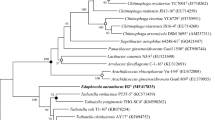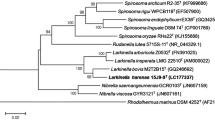Abstract
Strain U15T, rod-shaped, catalase and oxidase positive, non-motile, hot pink pigmented, Gram-negative bacterium, was isolated from soil of Udo port, Udo Island, South Korea. Growth was observed at 10–48 °C, pH 6–11, and 0% (w/v) NaCl. Optimum growth conditions are 30–40 °C, pH 7–10, and 0% (w/v) NaCl. Phylogenetic analysis based on 16S rRNA sequences showed that strain U15T forms a distinct clade with type strains of the family Cytophagaceae, with similarities below 89%. The major polar lipids are phosphatidylethanolamine and phosphatidylserine. Strain U15T was found to contain MK-7 as the only menaquinone, and iso-C15:0, C16:1ω5c, iso-C17:0 3-OH and summed feature 3 (comprising C16:1ω7c and/or C16:1ω6c) as the major fatty acids (> 10%). The DNA G + C content of strain U15T was determined to be 54.3 mol%. Based on the phylogenetic, phenotypic characteristics and chemotaxonomic analysis data, strain U15T (= KCTC 62116T = JCM 32361T) should be classified as representing a novel species of a novel genus within the family Cytophagaceae for which the name Tellurirhabdus rosea gen. nov., sp. nov., is proposed.

Similar content being viewed by others
References
Ausubel FM, Brent R, Kingston RE, Moore DD, Seidman JG, Smith JA, Struhl K (eds) (1995) Short protocols in molecular biology: a compendium of methods from current protocols in molecular biology, 3rd edn. Wiley, New York
Collins MD, Jones D (1981) Distribution of isoprenoid quinone structural types in bacteria and their taxonomic implication. Microbiol Rev 45:316–354
Fautz E, Reichenbach H (1980) A simple test for flexirubin type pigments. FEMS Microbiol Lett 8:87–91
Felsenstein J (1985) Confidence limits on phylogenies: an approach using the bootstrap. Evolution 39:783–791
Gerhardt P, Murray RGE, Wood WA, Krieg NR (1994) Methods for general and molecular bacteriology. American Society for Microbiology, Washington
Gonzalez JM, Saiz-Jimenez C (2002) A fluorimetric method for the estimation of G + C mol% content in microorganisms by thermal denaturation temperature. Environ Microbiol 4:770–773
Hall T (1997) BioEdit. Biological sequence alignment editor for Win 95/98/NT/2 K/XP. Ibis Therapeutics, Carlsbad
Hiraishi A, Ueda Y, Ishihara J, Mori T (1996) Comparative lipoquinone analysis of influent sewage and activated sludge by high-performance liquid chromatography and photodiode array detection. J Gen Appl Microbiol 42:457–469
Jiang F, Xiao M, Chen L, Kan W, Peng F, Dai J, Chang X, Li W, Fang C (2013) Huanghella arctica gen. nov., sp. nov., a bacterium of the family Cytophagaceae isolated from Arctic tundra soil. Int J Syst Evol Microbiol 63:696–702
Kang J, Chun J, Choi A, Cho J, Jahng K (2013) Nibrella saemangeumensis gen. nov., sp. nov. and Nibrella viscosa sp. nov., novel members of the family Cytophagaceae, isolated from seawater. Int J Syst Evol Microbiol 63(12):4508–4514
Kimura M (1980) A simple method for estimating evolutionary rates of base substitutions through comparative studies of nucleotide sequences. J Mol Evol 16:111–120
Komagata K, Suzuki KI (1987) Lipid and cell-wall analysis in bacterial systematics. Methods Microbiol 19:161–205
Kumar S, Stecher G, Tamura K (2016) MEGA7: Molecular evolutionary genetics analysis version 7.0 for bigger datasets. Mol Biol Evol 33:1870–1874
Kuykendall LD, Roy MA, O’Neill JJ, Devine TE (1988) Fatty acids, antibiotic resistance and deoxyribonucleic acid homology groups of Bradyrhizobium japonicum. Int J Syst Evol Microbiol 38:358–361
Larkin MA, Blackshields G, Brown NP, Chenna R, McGettigan PA, McWilliam H (2007) Clustal W and Clustal X version 2.0. Bioinformatics 23:2947–2948
Lee JJ, Lee YH, Park SJ, Lee SY, Kim BO, Ten LN, Kim MK, Jung HY (2017) Spirosoma knui sp. nov., a radiation-resistant bacterium isolated from the Han River. Int J Syst Evol Microbiol 67:1359–1365
McBride MJ, Liu W, Lu X, Zhu Y, Zhang W (2014) The family cytophagaceae. In: Rosenberg E, DeLong EF, Lory S, Stackebrandt E, Thompson F (eds) The prokaryotes. Springer, Berlin
Minnikin DE, O’Donnell AG, Goodfellow M, Alderson G, Athalye M, Schaal A (1984) An integrated procedure for the extraction of bacterial isoprenoid quinones and polar lipids. J Microbiol Methods 2:233–241
Powers EM (1995) Efficacy of the Ryu nonstaining KOH technique for rapidly determining gram reactions of food-borne and waterborne bacteria and yeasts. Appl Environ Microbiol 61:3756–3758
Rosselló-Móra R, Trujillo ME, Sutcliffe IC (2017) Introducing a digital protologue: timely move towards a database-driven systematics of archaea and bacteria. Syst Appl Microbiol 40:121–122
Saitou N, Nei M (1987) The neighbor-joining method: a new method for reconstructing phylogenetic trees. Mol Biol Evol 4:406–425
Vancanneyt M, Nedashkovskaya OI, Snauwaert C, Mortier S, Vandemeulebroecke K, Hoste B, Dawyndt P, Frolova GM, Janssens D, Swings J (2006) Larkinella insperata gen. nov., sp. nov., a bacterium of the phylum ‘Bacteroidetes’ isolated from water of a steam generator. Int J Syst Evol Microbiol 56:237–241
Weisburg WG, Barns SM, Pelletier DA, Lane DJ (1991) 16S ribosomal DNA amplification for phylogenetic study. J Bacteriol 173:697–703
Weon HY, Noh HJ, Son JA, Jang HB, Kim BY, Kwon SW, Stackebrandt E (2008) Rudanella lutea gen. nov., sp. nov., isolated from an air sample in Korea. Int J Syst Evol Microbiol 58:474–478
Yoon SH, Ha SM, Kwon S, Lim J, Kim Y, Seo H (2017) Introducing EzBioCloud: a taxonomically united database of 16S rRNA gene sequences and whole-genome assemblies. Int J Syst Evol Microbiol 67:1613–1617
Acknowledgements
We are grateful to Dr. Bernhard Schink for help with etymology. This research was supported by the National Research Foundation of Korea (NRF) grant funded by the Korea government (MIST) (NRF-2017R1A2B4009448).
Author information
Authors and Affiliations
Corresponding author
Ethics declarations
Conflict of interest
The authors declare that they have no conflicts of interest.
Additional information
Publisher's Note
Springer Nature remains neutral with regard to jurisdictional claims in published maps and institutional affiliations.
Electronic supplementary material
Below is the link to the electronic supplementary material.
Rights and permissions
About this article
Cite this article
Choi, J., Yang, D., Chhetri, G. et al. Tellurirhabdus rosea gen. nov., sp. nov., a new member of the family Cytophagaceae isolated from soil in South Korea. Antonie van Leeuwenhoek 112, 1047–1054 (2019). https://doi.org/10.1007/s10482-019-01238-y
Received:
Accepted:
Published:
Issue Date:
DOI: https://doi.org/10.1007/s10482-019-01238-y




